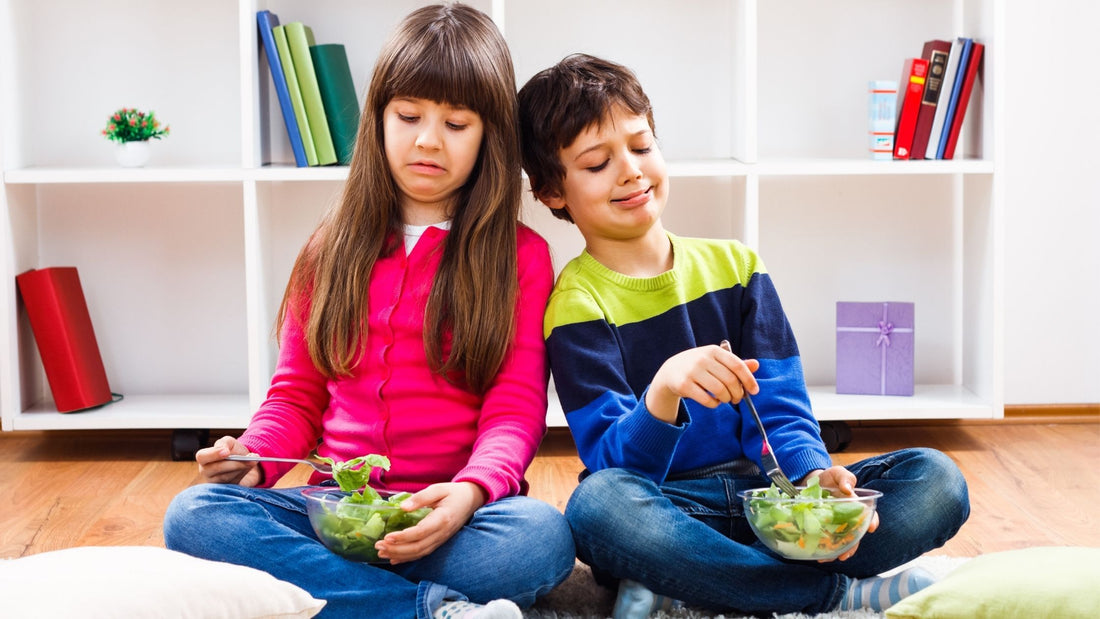
How to Get Your Child to Eat More Vegetables
Naturally YoursShare

‘Finish your vegetables’- is a common dialogue heard in every home during mealtimes.
Our parents have told this a thousand times when we were small and now we repeat the same instruction to our kids.
The struggle to make children eat vegetables often turn the dining table into a negotiating table. Parents will try every method possible-bribing, coaxing and even issuing silly threats of reduced TV time, in an attempt to get kids have a few mouthfuls of vegetable portions.
Let’s face it- it is a tall order for many of us parents to make our children eat healthy. We are always looking for methods to include vegetables in meals in hopes that kids will develop an acquired taste to their least favourite vegetable.
As the little ones become picky with food, parents have to be sneakier.
Here we give you some tips and five healthy recipes to tweak kids’ meals to include goodness of vegetables.
1. ‘Mask’ the flavours
Children are biologically hardwired to dislike vegetables.
Smell and taste are two means by which mother nature signals living beings whether something is poisonous or edible. Sweeter plants are generally safe to eat while bitter taste signals presence of toxins or poisons.
Naturally, instinct kicks in and kids avoid bitter tasting foods and vegetables like broccoli, cabbage, sprouts and leafy greens.
One way to ensure adequate portions for these veggies in kids’ diet is to mask the natural taste with some flavour that kids actually enjoy.
With a generous sprinkle of oregano, you can turn a simple broccoli stir fry to an enjoyable side dish for dinner. Children will surely like something that tastes similar to pizza.
Use herbs, sauces and dips to spice up the veggies. Curd is another option that pairs well with fresh cut vegetables. Raita is a good alternative to plain salads.
2. Make veggies colourful and interesting
Try different cooking techniques like frying, oven roasting and pureeing. Do not hesitate to experiment with presenting vegetables in different forms and textures.
Make the veggies look ‘fun’ by cutting them to simple shapes like stars or hearts or make a carrot face with a tomato smiley on a piece of bread along with a dash of cheese.
Small children always fall for this trick. They will be also be interested in trying a sandwich with colorful fillings or a rainbow salad with their choice of homemade dip.
3. Stock on stock
Plain vegetable stock is a nutritious and versatile ingredient.
Prepare and store a basic veg stock by boiling diced carrots, celery, white onions, cabbage cauliflower etc. in water (over high flame) along with salt and few garlic pods.
To make it more savoury, add a few herbs like thyme, parsley or basil.
Strain the water, cool it down and store in refrigerator. The boiled vegetables can be pureed and mixed with soups and curries.
Vegetable stock can be used in soups, as dressing for salads, in curry gravies and for flavouring rice dishes like pulav.
But the sneakiest way in which I use this stock is while making rotis. I have replaced water with this stock while kneading the dough and my kids have not noticed any difference in taste!
4. Make vegetables invisible
Make vegetables ‘disappear’ from kid’s food by using vegetable powders.
You can buy these vegetable powders at stores or make it at home. Adding some powdered vegetables will also make the food a lot more colourful.
With moringa powder and beetroot powder, you can make colourful rotis or puris.
Arrowroot powder and tapioca powder are rich in starch and can be used instead of corn flour.
Raw banana powder is used as a traditional baby food in south India. Raw banana powder porridge is easily digestible and extremely nutritious dish that even adults can try.
Some tasty recipes for you to try
Vegetable Dosas:
- Soak rice and urad dal(ratio 2:1) for at least 6 hours. Blend this in mixer-grinder with enough water to form batter. If you prefer non-fermented batter, prepare the mixture just before making dosas. Else, keep the batter outside, in a steel vessel overnight.
- Grate and add vegetables like beetroot or carrot into this batter. Add one or two tbsps. of finely chopped tomatoes and onions. Add salt to taste. Ensure that that vegetables are either chopped or minced into fine pieces. In that way they blend well into the batter and cook properly so that the vegetables would not stand out in the dish.
- Heat a tava and grease it with a bit of oil. Pour the batter and spread it round to make colourful dosas.
- You can replace raw urad-dal with raw jack-fruit during seasons. Soak and grind rice as usual along with two dried red chillies and salt. Remove the raw jackfruit pods and discard the seeds. Cut them to small pieces and grind them separately. The ratio of rice to jackfruit should be 1: 2. Mix the pureed jackfruit into the rice batter. Add a few pepper corns and curry leaves. Pour it on the tava to make tasty jackfruit dosas.
Benefits: Both carrots and beets are rich in dietary fibre. They are good for digestion and keep the gut healthy. Carrots are also rich in anti-oxidants. Jackfruit contains in Vitamins C and B. It has carotenoid, which is rich in Vitamin A.
Mixed vegetable sauce for pasta
- Heat olive oil in a pot and add chopped garlic and onions for a few minutes. Now add sliced vegetables like carrots, zucchini, bell peppers, celery etc. and cook for another few minutes.
- Add salt, chilli peppers and dried herbs like oregano or basil or a few pinches of fresh mint till the flavours are released. Now add freshly pureed tomatoes and simmer until the vegetables are cooked properly.
- Add boiled chickpeas and cook for another 2 minutes. Blend the mixture in a mixer to get creamy and spicy spaghetti sauce.
- Use this sauce for pasta instead of the store bought one.
Benefits: This sauce is a nutrient rich food. The chickpeas are rich in protein and adds to the kid’s daily nutrition requirement. Vitamin A in zucchini is good for immune system. It also contain Vitamin K and magnesium which strengthens bones.
Savoury oats pancakes
- Mix some powdered oatmeal with buttermilk and few drops of lemon juice. Add enough water to form a thick batter. Let this sit for 25-20 mins.
- Add vegetables-finely shredded cabbage, boiled green peas, shredded spinach, carrots, thinly cut beans, chopped onions, tomatoes and a few pods of garlic.
- Add salt to taste and a tea spoon of garam masala powder. Mix well and add one sachet of fruit salt. Stir well.
- Heat the skillet, grease it with butter or oil and spread the batter to make small pancakes. Oat batter tends to thicken as you keep it for a long time. Add water as needed to maintain the consistency.
Benefits: Oatmeal helps to reduce cholesterol and stabilizes blood sugar. The vegetables used in this recipe are excellent sources of vitamins, iron, zinc and anti-oxidants.
Yam and tapioca fry
Elephant foot yam(suran) is somewhat an unpopular vegetable among kids. Serve yam fries or tapioca fries instead of potato fries as snacks.
- Peel off the yam skin and wash it to remove any remaining mud. Cut them into small, even cubes.
- Put them in hot water for 2 minutes (remove immediately) and spread the cubes on a flat surface to let the water dry completely. Heat oil in a pan and deep fry the cubes, sprinkling some salt water on them, in between.
- If you are frying tapioca, make medium thick strips instead of cutting into cubes.
Benefits: Tapioca is naturally gluten free and therefore suitable for those suffering from celiac disease and gluten sensitivity. It is high in starch content and easy on stomach.
It is low in sodium and good source of calcium and iron. Elephant foot yam contains isoflavones which are good for skin. Yams are easily digestible and is said to promote and regulate hormones.
Veg stew in coconut milk
- Pressure cook diced potatoes, carrots, french beans, green peas and thinly sliced onions with two or three slit green chillies, a half inch piece of ginger, a small piece of cinnamon, 2 or 3 cloves and 4 peppercorns. Add salt to taste.
- Make sure the vegetables are soft and not mushy. Also, do not add too much water to vegetables, otherwise the gravy will be very thin.
- Scrape and grind one small coconut. Squeeze the milk using a sieve, slowly adding water. The coconut milk should be neither too thick nor too thin. Hence adjust water accordingly.
- Slowly add the coconut milk to simmering vegetables. Throw in a handful of curry leaves and add a teaspoon of coconut oil. Give it a good stir and take the stew off the stove.
- Remember to add coconut milk only towards the end. Make sure to turn off the stove immediately after adding milk, otherwise the gravy will be lumpy. This delicious stew can be paired with appams, idlis, rotis and even plain sweet bread.
Benefits: This stew has mild sweet and spicy flavour that children will like. The nutrients in the vegetable are preserved in the gravy as the cooked water is not discarded.
Coconut milk is rich in lauric acid which supports immune system. Green beans contain many essential vitamins such as Folate and is rich in protein.
